Developments Science and Technology
1. Development of science and technology in India:
India has a rich inheritance of science and technology. Scientific development in India is old age practice. From the ancient Indus Valley Civilization to the present day, scientific and technological progress in India has flourished. If appraise progress in ancient time, it is documented in studies that in ancient period, India had close contiguity in religion and science. There were several developments in the different branches of science in the ancient period.
1.1 Scientific and technological developments in ancient India:
In ancient time, India had made great progress in astronomy. The movement of planets came to be emphasized and closely observed. Jyotishvedanga texts established systematic categories in astronomy but the more basic problem was dealt by Aryabhatta (499 AD). His Aryabhattiya is a succinct text containing 121 verses. It contains separate sections on astronomical definitions, methods of determining the true position of the planets, description of the movement of the sun and the moon and the calculation of the eclipses. He gave good explanation for eclipse that the earth was a sphere and rotated on its axis and when the shadow of the earth fell on the moon, it caused Lunar eclipse and when the shadow of the moon fell on the earth, it caused Solar eclipse.In contrast, the orthodox theory explained it as a process where the demon swallowed the planet. All these observations have been described by Varahamihira in Panch Siddhantika which gave the summary of five schools of astronomy present in his time. Aryabhatta diverged from Vedic astronomy and explained it in scientific manner which became a guideline for future astronomers. Astrology and horoscope were studied in ancient India. Aryabhatta’s theories exhibited a distinct departure from astrology which stressed more on beliefs than scientific investigations.
In the field of Mathematics, the people possessed optimum knowledge of measurement and geometry. By third century AD, mathematics developed as a separate area of study. Indian mathematics is supposed to have originated from the Sulvasutras. Apastamba in second century BC, introduced practical geometry involving acute angle, obtuse angle and right angle. This knowledge helped in the construction of fire altars where the kings offered sacrifices. The three main contributions in the field of mathematics were the notation system, the decimal system and the use of zero. The notations and the numerals were done to the West by the Arabs. These numerals replaced the Roman numerals. Zero was discovered in India in the second century BC. Brahmagupta’s Brahmasputa Siddhanta is the very first book that mentioned ‘zero’ as a number, hence, Brahmagupta has originated zero. He gave rules of using zero with other numbers. Aryabhatta discovered algebra and also formulated the area of a triangle, which led to the origin of Trignometry. The Surya Siddhanta is a very famous work. Varahamihira’s Brihatsamhita of the sixth century AD is another original work in the field of astronomy. His observation that the moon rotated around the earth and the earth rotated around the sun found recognition and later discoveries were based on this declaration. Mathematics and astronomy together developed and scientists took interest in cosmology. These discoveries in astronomy and mathematics became the foundations for further research and progress.
During ancient time, medicine field was also progressed. Diseases, cure and medicines were mentioned for the first time in the Atharva Veda. Fever, cough, constipation, diarrhoea, dropsy, sores, leprosy and seizure are the diseases mentioned. The medications recommended were replete with magical charms and spells.
From 600 BC, rational sciences were introduced. Takshila and Taranasi emerged as centres of medicine and learning. The two important texts in this field are Charaksamhita by Charak and Sushrutsamhita by Sushruta. These were considered as important as such knowledge of medicine was circulated in China, Central Asia through translations in various languages.
The plants and herbs also used for medicinal purposes during ancient time. It was mentioned in Charaksamhita. Surgery came to be mentioned as a separate stream around fourth century AD. Sushruta was an inventor of this discipline. He considered surgery as “the highest division of the healing arts and least liable to fallacy”. He mentioned 121 surgical instruments. Along with this, he also mentioned the methods of operations, bone setting, cataract and other. The surgeons in ancient India were accustomed with plastic surgery (repair of noses, ears and lips). Sushruta mentioned 760 plants. All parts of the plant roots, barks, flowers, leaves etc. were used for medicinal purposes. During that time, doctors put more stress on diet (e.g. salt free diet for nephrites) to become healthy. Both the Charaksamhita and the Sushrutsamhita became the precursors of the development of Indian medicine in the later centuries. However, surgery suffered in the early medieval time since the act of dissecting with a razor became the work of a barber.
Metallurgy was also developed to full swing in ancient period. The glazed potteries and bronze and copper artefacts found in the Indus valley excavations which indicated towards a highly developed metallurgy. The Vedic people were aware of fermenting grain and fruits, tanning leather and the process of dyeing.
By the first century AD, mass production of metals like iron, copper, silver, gold and of alloys like brass and bronze took place. The iron pillar in the Qutub Minar complex is symbolic of the high quality of alloying that was being done. Alkali and acids were produced and used for making medicines. This technology was also used for other crafts like producing dyes and colours. Textile dyeing was popular. The Ajanta murals echo on the quality of colour.
The study of geography was also main interest of people in ancient period. The constant interaction between man and nature enforced people to study geography. Though the people were clear about their own physical geography, that of China and also the Western countries, they were ignorant of their position on the earth and the distances with other countries. Indians also contributed to shipbuilding. In the ancient period, voyages and navigation was not a familiar incursion for the Indians. However, Lothal, a site in Gujarat has the remains of a dockyard proving that trade flourished in those days by sea. In the early medieval period with the development of the concept of tirtha and tirtha yatra, a vast mass of geographical information was accrued. They were finally compiled as parts of Puranas. In many cases separate sthala purana was also compiled.
1.2 Scientific and technological developments in medieval India:
During the medieval period that was in eleventh to eighteenth century, science and technology in India advanced in two ways. One concerned with the already charted course of earlier traditions and the other with the new influences which came up as a result of Islamic and European influence. Muslim monarchs tried to reform the curriculum of primary schools. Some important subjects like arithmetic, mensuration, geometry, astronomy, accountancy, public administration and agriculture were included in the course of studies for primary education.In the field of biology, Hamsadeva gathered Mrga-pasi-sastra in the thirteenth century which gives a general, though not always scientific explanation of some of the beasts and birds of hunting. The medieval sovereigns were as warriors and hunters, kept animals such as horses, dogs, cheetahs and falcons. Animals, both domesticated and wild, existed in their menageries. During medieval era, there was lots of progress in the arena of mathematics. Brahmagupta the great who was mathematician of his time, had given an account of negative numbers as debts and positive numbers as fortunes, which demonstrates that ancient Bharatiyas knew the utility of mathematics for practical trade. In the beginning medieval period the two exceptional works in mathematics were Ganitasara by Sridhara and Lilavati by Bhaskara. Ganitasara deals with multiplication, division, numbers, cubes, square roots, mensuration, and so on. Ganesh Daivajna produced Buddhivilasini, a commentary on Lilavati, containing a number of illustrations.
In chemistry field, this period witnessed considerable reformation. Before the introduction of writing paper, ancient literature was preserved generally on palm leaves in South India and birch-bark (bhoj-patra) in Kashmir and other northern regions of the country. Use of paper began during the medieval period. Kashmir, Sialkot, Zafarabad, Patna, Murshidabad, Ahmedabad, Aurangabad, Mysore were known centres of paper production. During the era of Tipu Sultan, Mysore possessed a paper-making factory, producing a special type of paper that had a gold surface. The paper making method was more or less the same throughout the country, only differed in preparation of the pulp from different raw materials. The Mughals knew the procedure of production of gunpowder and its use in guns. Indian craftsmen learnt the technique and evolved suitable explosive compositions. They were aware of the method of preparation of gunpowder using saltpetre, sulphur and charcoal in different ratios for use in different types of guns.
In medicine field, there was an attempt to develop specialised treatises on different diseases. Pulse and urine examinations were conducted for diagnostic purposes. The Sarangdhara Samhita recommends use of opium for medicines. The rasachikitsa system, dealt chiefly with a host of mineral medicines including metallic preparations. The Unani Tibb is an important system of medicine which thrived in India in the medieval period.
In the medieval period, the form of agricultural practices was almost the same as that in early ancient India. Some important changes, however, were brought about by the foreigners such as the introduction of new crops, trees and horticultural plants. The principal crops were wheat, rice, barley, millets, pulses, oilseeds, cotton, sugarcane and indigo.
1.3 Advancement of science and technology is observed in following areas in modern time:
Significant achievements have been made in India in the areas of nuclear and space science, electronics and defence. The government is committed to make science and technology an integral part of the socio-economic development of the country. In the context of India, science and Technology (S & T) have always been an integral part of Indian culture. Natural philosophy ancient times, was chased energetically at institutions of higher learning. The Indian Resurgence, which accorded with our independence struggle, at the beginning of 1900s observed great steps made by Indian scientists, who have left ineffaceable traces at global level. The Government confidently believed that science and Technology would be the major tool that will assist to bring social equality and economic progress. These advancements also enable India to come in the mainstream of world community. This principle was reflected in the Scientific Policy Resolution (SPR) of 1958. In this period numerous scientific department were established. The Department of Atomic Energy (DAE), the Department of Science and Technology (DST) and the Department of Space (DOS) were among the first S & T departments in the country.The Department of Science and Technology was established in May, 1971. The aim of DST was to promote new areas of science and technology and to be the nodal department for coordinating those areas of science and technology in which a number of institutions and departments have interest and capabilities. Thus, the DST has imperative role in promoting basic research and technology development in the country. The DST also assists in formulation of policy statements and guidelines on S & T.
Figure: Science and technology system in India

India has advances in science and technology in following areas:
- Atomic energy
- Space
- Telecom
- E governance
- Electronics
- Oceanography
- Biotechnology
- IT
- Primary and tertiary industries
Figure: Central government science and technology department
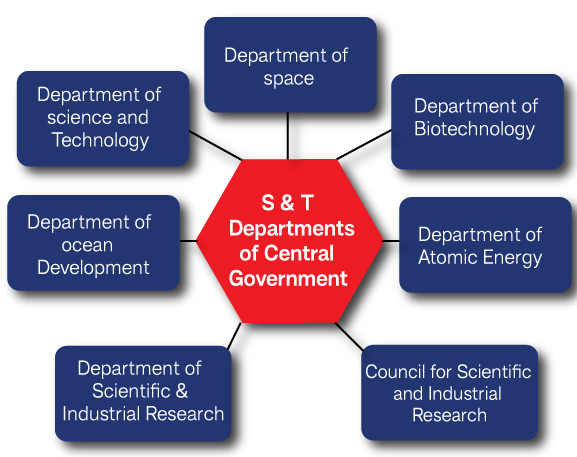
Atomic energy:
India has good position in world and considered as one of the most progressive countries in the arena of nuclear technology including production of source materials. The country is self-reliant and has become proficient at the expertise covering the complete nuclear cycle from exploration and mining to power generation and waste management. Accelerators and research and power reactors are now designed and built indigenously. The sophisticated variable energy cyclotron at Kolkata and a medium-energy heavy ion accelerator 'pelletron' set up recently at Mumbai are national research facilities in the frontier areas of science. As part of its programme of passive uses of atomic energy, India has also boarded on a programme of nuclear power generation. India has enormous demand of power supply and by 2020 the existing demand is likely to double. Per Capita electricity consumption seems to grow manifold and India had to search for other energy sources for generation of electricity. Nuclear technology came to its rescue. India has knowledge of fast reactors and Thorium fuel cycle which will take it to one of the leaders’ positions in nuclear technology. India’s aim is to utilise nuclear energy for peaceful purposes.Table: Nuclear Power Generation (2006-07 to 2015-16)

During the last sixty three years, since the establishment of the Atomic Energy Commission in 1948, India has made significant progress in the field of nuclear technology. In 1957, the Bhabha Atomic Research Centre (BARC) was established at Trombay. It is the largest single scientific establishment in the country. Nuclear power stations have already been established at Tarapur (Maharashtra), Kota (Rajasthan), Kalpakkam (Tamil Nadu), Narora (UP) and Kakrapar (Gujarat). The espousal of modern technology has led to the increase in indigenous content of nuclear power reactors constructed in India. As a result, India is today one of the few countries in the world which can indigenously design, construct and operate nuclear reactors without relying on foreign help.
Table: Nuclear plants
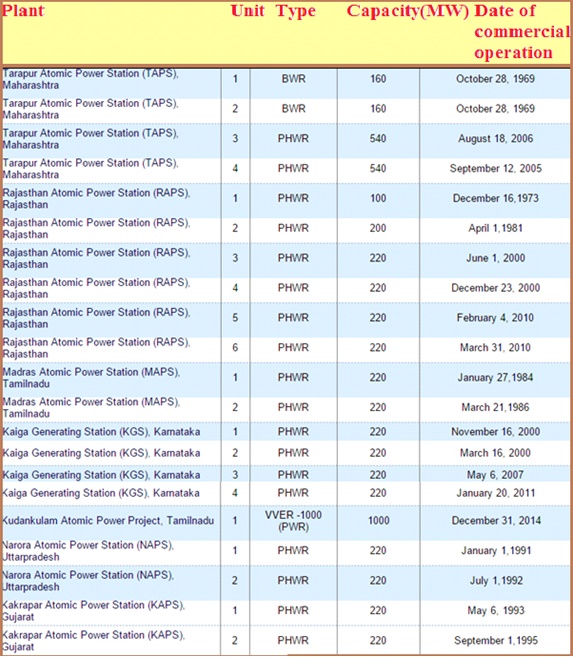
Major aim of nuclear energy programme in India is the development and use of nuclear energy for peaceful purposes such as power generation, applications in agriculture, medicine, industry, research and other areas. India has good standing among the countries as most advanced in nuclear technology including production of source materials. The country is self-reliant and has mastered the expertise to cover the complete nuclear cycle-from exploration and mining to power generation and waste management. Accelerators and research and power reactors are now designed and built indigenously. The refined variable energy cyclotron at Kolkata and a medium energy heavy ion accelerator ‘pelletron’ set up at Mumbai are national research facilities in the frontline areas of the science. As part of its programme for peaceful uses of atomic energy, India has also boarded on a program of nuclear power generation. Eight nuclear stations are producing 8 billion kilowatts of electricity. The new nuclear reactors have been completely designed in India. The peaceful nuclear programme also includes producing radio-isotopes for use in agriculture, medicine, industry and research.
2. Space research:
The Indian space programme is focussed on the goal of self-reliance in the use of space technology for national development. Over the years, the space programme has established itself with a series of achievements. They include the launching of the first Indian space satellite Aryabhatta in 1975 and then Bhaskara I and Bhaskara II from the Soviet Union, the Rohini satellite on India’s own SLV-3 rocket and the Apple satellite on the European Arianne rocket. A far reaching experiment in education through satellite, SITE, was conducted in India in 1975. Subsequently, INSAT I-IB, launched in 1983, provided radio, television, telecommunication and meteorological services. A perspective of major space mission planned for the decade 1985-95 aims at using space technology for nationwide application in communication, survey and management of natural resources and meteorology.The Indian Space Research Organisation (ISRO), under the Department of Space (DOS), is the organization that involve in extensive research, development and operationalization of space systems in the areas of satellite communications, remote sensing for resource survey, environmental monitoring, and meteorological services. Department of Space is also the nodal agency for the Physical Research Laboratory, which conducts research in the areas of space science, and the National Remote Sensing Agency, which deploys modern remote-sensing methods for natural resource surveys and provides operational services to user agencies.
The technique of satellite communication is being used today for many purposes which are technical progression in space science. Such as telephonic conversations and conferencing, television broadcast, FAX and computer related network services. A satellite being used for this purpose is called a communication satellite. Space scientists have built high television towers to reach longer distances. A communication satellite is like a 36000 km high television tower, and signals broadcast from it reach almost half the Earth.
Figure:Signal sent by station A to geo-stationary satellite S is retransmitted to TV-stations in almost half the Earth
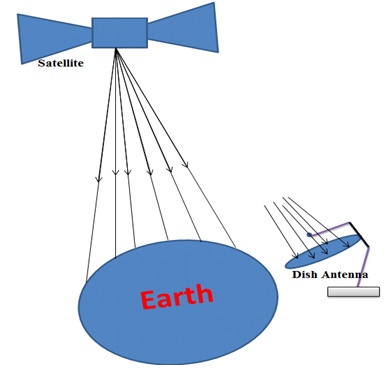
Weather monitoring and forecasting by satellite is also technical advancement in space science. A geo-stationary satellite is used to monitor weather. It is equipped with cameras and other sensors by which photographs of cloud formations and many other data about atmosphere in a vast area can be quickly obtained. The satellite being stationary relative to any place on earth, it can monitor the movement of clouds accurately.
Figure: A geostationary satellite is like a fixed observation station
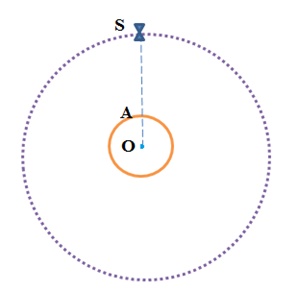
India is the only third world country to develop its own remote sensing satellite. Objectives for space research in India are:
- Rapid development of mass communication and education, particularly in widely dispersed rural communities.
- Timely survey and management of the country’s natural resources.
India entered in the space field on 19th March 1975 when the first Indian satellite Aryabhata was launched. It was designed and fabricated by Indian scientists but was launched with the help of USSR. It empowered Indian scientist to:
- Develop the skills of staff members and physical facilities for designing and fabricating satellite and monitoring their performance during journey.
- Establish ground facilities for communicating with satellite, tracking it, and to command it for carrying out various tasks.
- Conduct some experiments in the fields of X-ray astronomy, solar physics and meteorology.
Figure: Indian satellite Aryabhata
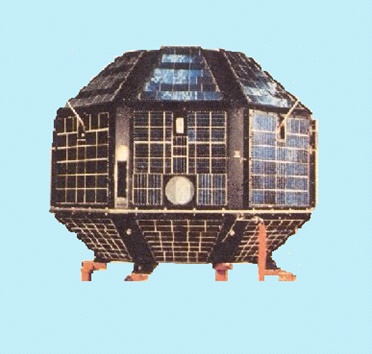
India joined a select group of six nations on October 15,1994, when the Polar Satellite Launch Vehicle (PSLV) efficaciously .accomplished its mission of placing the 800-kg remote sensing satellite, IRS-P2, in the intended orbit. The INSAT series of satellites launched earlier are performing well and provide vital services for telecommunications, television, meteorology, disaster warning and distress detection. The INSAT series include new features like Kit-band transponders and mobile satellite service, transponders. The remote-sensing satellites, launched in 1988 and 1991, have already become the strengths of the natural resource management system of the country.
The most important landmark of the Indian Space Programme during the year 2005-06 was the successful launch of PSLV-C6. On May 5, 2006, the ninth flight of Polar Satellite Launch Vehicle (PSLV-C6) from Satish Dhawan Space centre (SDSC) SHAR, Sriharikota successfully placed two satellites-1560 kg CARTOSTAR-1 and 42 kg HAMSAT-into a predetermined polar Sun Synchronous Orbit (SSO). The successful launch of INSAT-4A, the heaviest and most powerful Satellite built by India so far, on 22 December 2005 was the important event of the year 2005-06. INSAT-4A is capable of providing Direct-To-Home (DTH) television broadcasting services. It is well recognized that the Indian space programme arrived a new age when ISRO’s Polar Satellite Launch vehicle (PSLV)-C7 successfully launched on January 10, 2007 four satellites into high polar orbit from Satish Dhawan Space Centre (SDSC), Sriharikota. The four satellites put into orbit were India’s CARTUSAT-2 and space Capsule Recovery Experiment. (SRE-1), Indonesia’s LAPAN-TUBSAT and Argentina’s PEHUENSAT-1.
Figure: Indian satellite launch vehicles
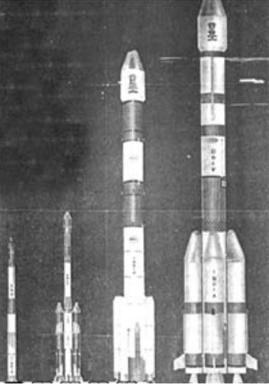
The Indian accomplishment in the application of space-based remote sensing technology has pushed a US company to sign an agreement for marketing the data from Indian satellites globally. India’s incredible advancements in space technology has fascinated global attention and demand, with leasing agreements for marketing of IRS data and supply of space hardware and services. India also considers that there must be co-operation in space with agencies around the globe. A high-level UN team nominated India to form a UN Centre for Space Science and Technology Education. India is on the edge of accomplishing self-reliance in the launch competence. It will be great tribute to originator of the Indian space program, Dr. Vikararn Sarabhai.
3. Telecom:
In new millennium, there are unprecedented transformation and up gradation in the area of telecom. In Indian context, it is observed that country is engaged in speedy growth of its telecommunications infrastructure. Numerous reports indicated that the Indian Telecom Sector has arisen as one of the critical components of economic growth required for overall socio-economic development of the country as there is a positive correlation between the penetration of mobile services and internet on the growth of GDP of a country. To accelerate telecom development, the government has licensed one private Basic Services Operator (BSO) in each state, to set up an independent telecom network in the state. The inter-state network and international links will be operated by the government-owned monopoly operator (DoT) for the time being. The DoT, of course, is previously an operator in all the states, and is expanding its subscriber base every year. The telecom network has been built along conventional lines, similar to networks in developed countries. The long-haul support network is mostly digital network and employs optical fibre, microwave and satellite links.The Indian telecom services can be divided predominantly into basic, mobile and Internet service. It also comprises smaller segments, such as radio paging services, Very Small Aperture Terminals (VSATs), Public Mobile Radio Trunked Services (PMRTS) and Global Mobile Personal Communications by Satellite (GMPCS).
Figure:telecom service in india
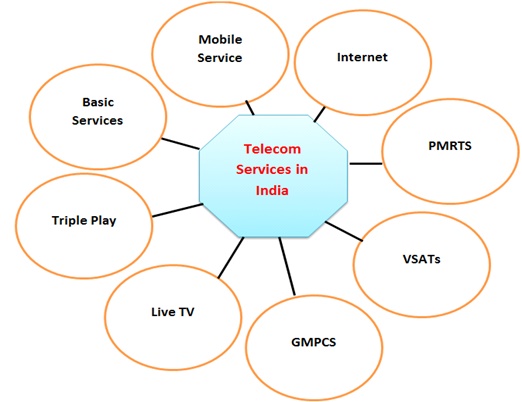
After post-liberalization, rapid growth on Telecom Sector in India can be perceived, which supported nation to enhance economic status of country (Nasit, 2011). Earnst and Young (2011) stated that Indian telecom is an economic phenomenon in the making. They believed that connecting such an effervescent economy of more than a billion people together is an extraordinary achievement in terms of a nation’s socioeconomic development. According to Shah (2008), the development of the Telecom Sector of India has experienced a major process of revolution in terms of its growth, technological content and market structure through policy reforms introduced by Government of India. According to Tarab (2012), the joint effort of Government and private sector companies has enhanced growth in telecom area. Active participation of the private companies, foreign direct investment, sequence of reform measures initiated by the Government and wireless technology has vital role in incredible growth of the sector in the country. It has become essential service, needed for fast growth and modernization of various sector of the country’s economy.
Table: Evolution of telecom sector (Source: bsnl.co.in):

4. E- governance:
The role of E-government is to organize public management in order to upsurge efficiency, transparency, accessibility and responsiveness to inhabitants through the intensive and strategic use of information and communication technologies in the inner management of the public sector (intra and inter-governmental relations) as well as in its daily relations with peoples and users of public services. In simple term, E-governance is an ICT-enabled tool to realize good governance. E-Governance offers novel solutions, helping improve government processes, connect citizens, and build interactions with and within civil society. E-governance has the power of ICTs, which provide three basic change potentials for good governance for development:- Automation: It means replacing the human-executed processes which involve accepting, storing, processing, outputting or transmitting information.
- Information: It means supporting human executed information processes like, supporting current processes of decision making, communication, and decision implementation.
- Transformation: It creates new ICT-executed information processes or supporting new human executed.
The e-Governance projects have numerous benefits such as cost effective solutions, improved and easy-to-access services to citizens, and improved processing of transactions both within the government and between the government and other agencies. The planning, implementation and monitoring of government programmes, projects and activities can be considerably strengthen by this application. Exponential growth of Internet has led governments in both developing and developed countries to use the technology for an efficient and effective service to the citizens. Besides fast, convenient, cheap and reliable delivery of the services, Internet technology permits to bring more transparency in governance and gives many benefits to the e-Governance community. The government services can be extended to all geographical segments all over the country in all days very quickly.
The most common interactions in e-governance are Government to Citizens (G2C), Citizens to Government (C2G), Government to Businesses (G2B) and Government to Government (G2G).
Figure: e-governance model
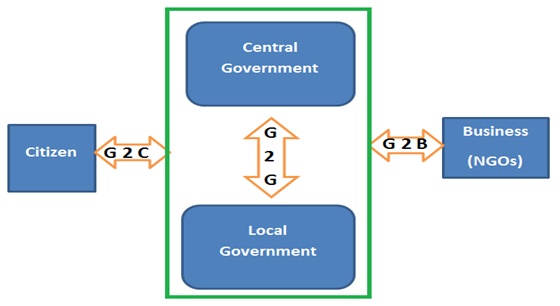
Several E-governance projects have got the attention of the world in India for their uniqueness and success.
Table: Some E-governance Initiatives in Indian States
|
State / Union
territory |
Initiatives covering
departmental automation, user charge collection, delivery of
policy/ programme information and delivery of entitlements |
|
Andhra Pradesh |
e-Seva, CARD, VOICE,
MPHS, FAST, e-Cops, AP online-One-stop-shop on the Internet,
Saukaryam, Online transaction processing, APSWAN (Andhra
Pradesh State Wide Area Network), Gram Dootha |
|
Bihar |
Sales Tax
Administration management Information |
|
Chhatisgarh |
Chhatisgarh Infotech
Promotion Society, Treasury Office, e-Linking Project |
|
Delhi |
Automatic Vehicle
Tracking System, Computerisation of website of RCS office,
Electronic clearance system, Management information system for
education et. |
|
Goa |
Dharani Project |
|
Gujrat |
Mahiti Shakti, request
for government documents online, Form book online, G R Book
online, Census online, Tender notice, The Dairy Information
system Kiosk (DISK), Citizen service portal(CSP), Vishwa gram
project, Gyan ganga project |
|
Haryana |
Nai Disha |
|
Himanchal Pradesh |
Lok Mitra |
|
Karnataka |
Bhoomi, Khajane,
Kaveri, Bellandur, Karnatka, ICT enabled Gram Panchayat |
|
Kerala |
e-Srinkhala, RDNet,
Fast Reliable Instant Efficient Network for the Disbursement of
Service (FRIENDS) |
|
Kolkata |
Connecting the Cops WAN |
|
Madhya Pradesh |
Gyandoot, Gram Sampark,
Smart Card in Transport Department, Computerisation MP State
Agricultural Marketing Board (Mandi Board), E-Gram Suvidha,
Head Start |
|
Maharashtra |
SETU, Online complaint
management system, Mumbai, The Telemedicine Project, The Warana
wired villages initiative, One village one computer(1V1C) |
|
Punjab |
Punjabseva, Sukhmani |
|
Rajasthan |
Jan Mitra, RajSWIFT,
Lokmitra, RajNIDHI |
|
Tamil Nadu |
Rasi Maiyams,
Kanchipuram; Application forms related to public utility,
Tender notices and display |
|
North Eastern States |
Community Information
Center, Forms available on Meghalaya website under schemes
related to social welfare, food civil supplies and consumer
affairs, housing, transport etc. |
Since majority of people in India live in rural areas, there are more projects for this sector for democratizing the decentralization using e governance. The initiating efforts of establishing e-panchayats in villages need strengthening and spread to states and people as well. Internet based services for birth and death registrations, house tax assessment collections, trade licenses, old age pensions, works monitoring, financial accounting; MIS for Panchayat administration are needed to be offered and executed immaculately in the computerized e-Panchayat system. Some additional services like market prices and agricultural extension advice being provided to the citizens of certain villages are further to be extended to other states, however in customized context.
Some of the fruitful "e-Panchayat" projects and other such programs in India are Anantapur Rural (south) gram panchayat Andhra Pradesh, E-panchayats' in Chattisgarh, and process automation based e-governance in Tiruvarur district of Tamil Nadu.
Table: Major E-Governance Projects
|
Project name |
State |
Brief
description |
|
E-Choupal |
Madhya Pradesh, Karnataka,
Andhra Pradesh and Uttar Pradesh |
E-Choupal are created as a
network of information centres equipped with a computer connected to the
internet. The name is derived from the Hindi word ‘Choupal’ meaning a
‘traditional village gathering place’. The ultimate objective is to set
up enough number of e-Choupals in target states so that a farmer has to
travel no more than five kilometres to get an e-Choupal. Each e-Choupal
is intended to serve five to seven villages in the radius of five
kilometres. It reaches out to more than a million farmers in nearly
11,000 villages through 2000 kiosks across 4 states (Madhya Pradesh,
Karnataka, Andhra Pradesh and Uttar Pradesh). The average number of
farmers with access to a single e-Choupal is approximately 1,000. |
|
Akshaya |
Kerala |
‘Akshya’ – a project implemented
by IT Department, Government of Kerala with private sector
participation. Has been undertaken with the view to bridge the digital
divide by the successful discrimination of benefits of Information
Technology among people. It is expected to be the country’s largest
rural wireless network. It aims to improve public delivery of services
by bringing the benefits of e-Governance and utility services like basic
connectivity to individual households in Kerala.As of now, there are 620
ICT centres, with each centre servicing about 1000 families. |
|
Bhoomi |
Karnataka |
‘Bhoomi’ is the first
e-governance project of the Government of Karnataka in land records
Computerization system. It permits online updating of the land records
making it radically different from land record systems attempted
elsewhere in India. The project facilitates computerized delivery of 20
million rural land records to 6.7 million farmers through 177 Govt.
owned Kiosks in the Indian state of Karnataka which is fast becoming the
backbone for the credible IT-enabled Government services for the rural
population, thus, bringing relief for the marginalized sections. |
The concept of e-Governance and its implementation in leading states has provided experience, expertise and strength for incorporating e-governance. With the passage of time, the concept is expected to become more and more popular in the ‘things to do’ list of various states. Some states have already shown a strong commitment towards its initial experimentation and final in corporation.
5. Electronics:
The Department of Electronics has imperative and positive role for the expansion and use of electronics for socio-economic development. Many initiatives have been taken for a balanced growth of the electronics industry. After independence, India has developed the capability to produce array of electronic goods such as radio and television sets, communication systems, broadcasting equipment, radars, nuclear reactors, power control systems and underwater systems. A very large part of the components required for these are produced indigenously.The basic push has been towards a general rationalization of the licensing policy with an emphasis on promotion instead of regulation, besides achieving economy of scale with up- to-date technology. A multi-pronged approach has been evolved for result-oriented R & D with special emphasis on microelectronics, telematics, and high- performance computing and software development. Main R & D initiatives in electronics has been in the development of Linac tubes, automateion & Intelligent Transportation Systems technology, setting up of Nano electronics centres & generic Nanometrology facilities.
6. Oceanography:
Oceanology is the scientific study of the sea by applying traditional sciences, such as physics, chemistry, mathematics, etc., to all aspects of the ocean.
There are three major stages in the history of ocean research:
- Ocean exploration was the period when people explored the ocean boundaries. Prominent explorers include: The Phoenicians, Phytheas, The Polynesians, Herodotus, the Vikings, Bartholomew Diaz, Vasco de Gama, Ferdinand Magellan and Sebastian del Cano.
- Early scientific investigations began when people began to describe the ocean. Distinguished scientists include: James Cook, Matthew, Fountaine Maury, Charles Darwin, C. Wyville Thomson, and Fridjof Nansen.
- Modern oceanography or oceanology.
Application of modern scientific methods to study of ocean systems
Developments in oceanic exploration occurred in the twentieth century.
-Polar Exploration: Explorers reached both the North and South poles in the twentieth century
- The Meteor Expedition: The first expedition to use modern optical and electronic equipment for oceanographic investigation
- The Atlantis: Investigations by scientists on this research vessel confirmed the presence of the Mid-Atlantic Ridge.
- The Trieste: A blimp-like bathyscaphe which descended into the Challenger Deep area of the Mariana Trench
- Glomar Challenger: Samples obtained by scientists on this drilling ship provided confirming evidence for seafloor spreading and plate tectonics. First time computers were used on-board
In India, scientists have great interest in many field of ocean development, such as, exploration of offshore oil, fishery resources to increase food supplies. India has a coastline of more than 7,600 km and 1,250 islands, with its Exclusive Economic Zone covering over 2 million sq. km and continental shelf extending up to 350 nautical miles. Two research vessels, ORV Sagar Kanya and FROV Sagar Sampada, are assessing and evaluating the resource potential. A National Institute of Ocean Technology was established for the development of ocean-related technologies. It is also responsible for harnessing resources of the coastal belts and islands.
7. Biotechnology:
Biotechnology is a multidisciplinarian in nature, involving input from Engineering, Computer Science, Cell and Molecular Biology, Microbiology, Genetics, Physiology, Biochemistry, Immunology, Virology, Recombinant DNA Technology, Genetic manipulation of bacteria, viruses, fungi, plants and animals, often for the development of specific products, Biostatistics, Enzymology.India has been the foreshadowing among the developing nations in encouraging multidisciplinary activities in this area, recognizing the practically unlimited possibility of their applications in increasing agricultural and industrial production, and in improving human and animal life. The centre of research in this area is the National Biotechnology Board, constituted in 1982. Some of the initiatives taken include developing techniques for gene mapping, conservation of biodiversity and bio-indicators research, special biotechnology programmes for the benefit of the scheduled castes and scheduled tribes and activities in the area of plantation crops. The areas which have been receiving attention are cattle herd improvement through embryo transfer technology, in vitro propagation of disease resistant plant varieties for obtaining higher yields, and development of vaccines for various diseases.
The Biotechnology Consortium India Limited was set up for this. It plays the role of promoter in bridging the gap between Research and Development, Industrial and Financial Institutions. Some of the new initiatives taken include developing techniques for gene mapping, conservation of biodiversity and bioindicators’ research, special biotechnology programs for the benefit of the scheduled castes and scheduled tribes and activities in the area of plantation. The areas, which need attention, include cattle herd improvement through embryo transfer technology, in vitro propagation of disease resistant plant varieties for obtaining higher yields, and development of vaccines for various diseases. Council of Scientific and Industrial Research (CSIR) was established in 1942, and currently it is the best institution for scientific and industrial research. It has a network of 40 laboratories, two co-operative industrial research institutions and more than 100 extension and field centres. The research programs of the Council are mainly concerned with the effective utilization of the country’s natural resources and development of new processes and products for economic progress. It plays important role in the fulfilment of the technology missions developed by the Government.
Figure:industrial biotechnology
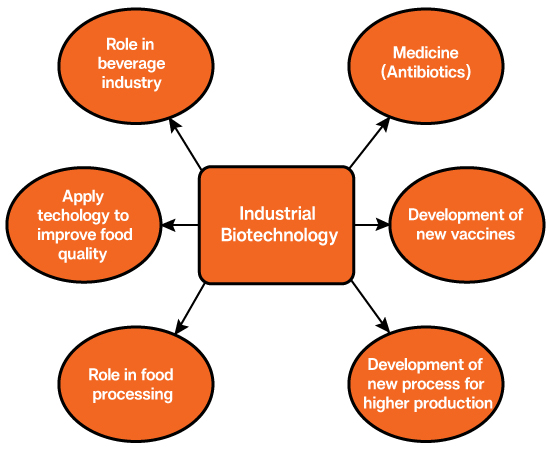
Modern biotechnology is visualized as an integration of new techniques with the well-established approaches of traditional biotechnology such as plant and animal breeding, food production, fermentation products and processes, and production of pharmaceuticals and fertilizers (Doyle and Persley 1996).
Major components of modern biotechnology are as under:
- Genomics: The molecular characterization of all genes in a species.
- Bioinformatics: The assembly of data from genomic analysis into accessible forms, involving the application of information technology to analyse and manage large data sets resulting from gene sequencing or related techniques.
- Transformation: The introduction of one or more genes conferring potentially useful traits into plants, livestock, fish and tree species.
- Genetically improved organism.
- Genetically modified organism (GMO).
- Living modified organism (LMO).
- Molecular breeding: Identification and evaluation of useful traits in breeding programs by the use of marker-assisted selection (MAS).
- Diagnostics: The use of molecular characterization to provide more accurate and quicker identification of pathogens.
Vaccine technology: The use of modern immunology to develop recombinant deoxyribonucleic acid (rDNA) vaccines for improved control of livestock and fish diseases (Doyle and Persley 1999).
Biotechnology consists of a gradient of technologies that range from the long-established and extensively used techniques of traditional biotechnology to novel and continuously evolving modem biotechnology techniques.
In the decade of 1970, scientists developed new methods for precise recombination of portions of deoxyribonucleic acid (DNA), the biochemical material in all living cells that governs inherited characteristics, and for transferring portions of DNA from one organism to another. This set of enabling techniques is referred to as rDNA technology or genetic engineering.Figure: Significant advances in biotechnology
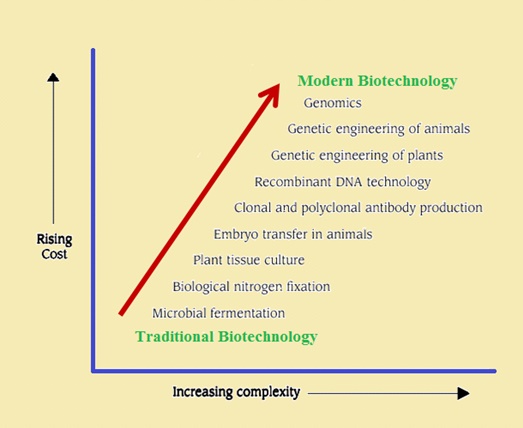
8. Information Technology:
Information technology denotes to the digital processing, storage and communication of information of all kinds. Therefore, IT can potentially be used in every sector of the economy. India is making revolutionary progress in the arena of information technology. Advent of wireless services has prepared the users with mobility and coverage in negligible price. Making unlimited video calls and voice calls all over the world have become free of cost with one-time payment for getting the service enabled. There are millions mobile users in India which makes it 2nd largest in the world. In the field of internet, it is third largest with 108 million users. 4G technology is definitely a boom currently.India’s software industry is more vigorous than its hardware industry, at least in certain areas. While selling packaged software to consumer (and most business) markets require economies of scale and scope, as well as marketing and customer support muscle, project oriented components of software development do not do so, to quite the same degree. The software development and use life cycle includes analysis and specification of requirements, design, coding, testing, installation, maintenance and support. Many of these activities, particularly coding and testing, involve relatively routine IT skills that India’s workforce has in large absolute numbers (though small relative to the total population).
The existence of the Indian Institutes of Technology (IITs), the ubiquity of Unix in academic environments, and the comparatively low infrastructure demands of learning to use and create software all worked in India’s favor on the supply side.
IT-enabled services are not essentially related to the production of software or IT in general, but use IT to make the provision of services possible. Customer call centers are one example, where Indians have been training to speak with American accents, in order to deal with customer queries from the US.
IT-Enabled Services Types:
- Customer Interaction Services
- Business Process Outsourcing / Management; Back Office Operations
- Insurance Claims Processing
- Medical Transcription
- Legal Databases
- Digital Content
- Online Education
- Data Digitization / GIS
- Payroll / HR Services
- Web site Services
Indian Military: India lies in a risky zone with two hostile countries, which have gone to war against it in the past. Indian Military has expanded its hardware to achieve modernization. India has always maintained that all its defence related developments are for peaceful and defensive measures. India has numerous advanced technology related talent. Defence research Organisations are doing well to bring out the best in the Indian Armed Force by either collaborating with foreign companies or developing technology & designs indigenously.
India has plenty of technology related talents, and defence research organisations are doing their part to bring out the best in the Indian Armed Forces, by either collaborating with foreign companies or developing technology and designs indigenously. Some have been acquired directly like the set up with the US, where India buys directly through the US foreign military sales (FMS) programme. The year 2013 saw the Indian Armed Forces commissioning aircraft-carrier Admiral Gorshkov that was renamed INS Vikramaditya, the first nuclear-powered ballistic missile submarine, INS Arihant's on-board nuclear reactor attained criticality and LCA Tejas getting its much-anticipated Initial Operational Clearance.
Agriculture: The period of modernization is observed in the entire sectors especially in the agriculture sector. Earlier, farmers had to struggle a lot to produce food grains, vegetables to meet their needs. In the modern times, farmers are equipped with latest agriculture technology to enhance their production and these are trouble free. Various advancements have been made in the arena of agriculture.
There is improvement in soil productivity. Soil being the most important resource in agriculture no productivity could be achieved without enriching it. It was therefore needed to identify the different types of soil and classify land resources accordingly. The country was divided into 186 resource areas and a soil atlas was contemplated. It was also decided to build up an inventory of difference soils across the country covering micro nutrients which would be helpful in the scientific management of land. The resulted spinoff of this was that large areas of saline/alkaline soils were reclaimed.
Developments in genetics helped in restructuring the genetic architecture of plants which resulted in the development of hybrid maize, cotton and dwarf wheat. These breakthroughs were made possible due to innovations in related areas like plant protection, breeding of resistant varieties and chemical control. Agriculture in India being a non-mechanized sector which depended on animal husbandry made it imperative to initiate research in cattle breeding.
Research was conducted for selective development of indigenous breeds and cross breeding which resulted in improved strains in cattle such as Karan Swiss and Karan Fries. Similar developments were also carried out amongst sheep and poultry. The breeding of buffaloes was improved by perfecting semen preservation technology. Understanding the importance to preserve rare species found in natural habitat, gene sanctuaries were setup. The nodal agency for this was the bureau of plant genetic resources which was established in 1976. This institution works in collaboration with other organizations like international plant genetic research institute. Innovation in agricultural machinery resulted in the development of chisel plow, puddler, manual and animal drawn seed cum fertilizer drill, power tiller operated paddy harvester, multi crop threshers, and grain dryers. Many innovative bio gas plants are also developed and research extended to areas like energy management, biotechnology and ecological infrastructure.
There is a new phenomenon on the Indian scenery, upsurge of the organized food and grocery retail sector. The organized food and grocery retail which was almost non-existent seven years back has been growing at a phenomenal pace.
Figure: Dynamics of the modern agri-food system (Source: Gulati and Ganguly, 2009)
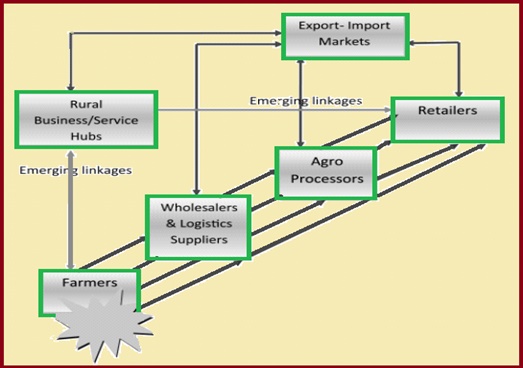
Health and medicine:
In the field of medicine, India has progressed well and there have been many achievements. It is witnessed that in health care, science and technology are entrenched in much broader social and institutional structures. For example, a research discovery can lead to experimental products in a very short time. Major developments have been made to prevent and treat various diseases. Small pox has been eradicated. Treatment of diseases like tuberculosis, malaria, filaria, goitre, and cancer has been considerably improved. Research is done to control communicable diseases.Research based activities have already augmented life expectancy appreciably and death rate has declined, while schemes such as the immunisation programme have reduced infant mortality considerably. Improved medical facilities in the form of government-run hospitals and dispensaries, research councils, and primary health centres for rural areas are also being provided. New technologies in the healthcare management systems consist of electronic data storage, data maintenance and exchange. Such process when implemented will make the healthcare management process effective. Example of such type of healthcare management system is Electronic Medical Records (EMR).
Figure: Revolution in medicine (Source: Nigel Kelly, Bob Rees, Paul Shuter’ 2003).
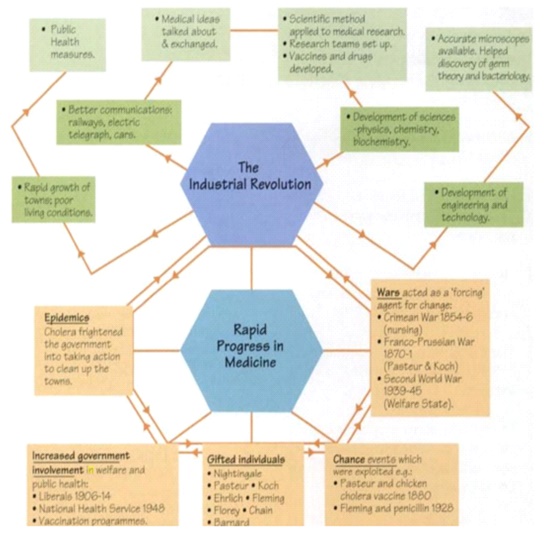
Industry:
In the field of industry, current science and technology made its most revolutionary impact. In India, the government has constantly adopted modern science and technology for industrial development. Two government organisations, Council for Scientific and Industrial Research (CSIR) and Defence Research and Development Organisation (DRDO) cover between them range of science and technology research for civil and defence purposes. A huge number of items have emerged from CSIR laboratories for industrial production, such as, indigenous agricultural machinery, chemicals, drugs and pesticides, products in the areas of food technology, finished leather goods, glass and ceramics, colour television, and receiver sets. The research performed in the field of coal, such as, upgrading of coal and production of electricity through coal as fuel has been successfully utilized. In the area of defence, India’s own technological capability has increased significantly.Besides above areas, India has made substantial progress in other fields. These include the activities of the Oil and Natural Gas Commission in oil exploration and refining and of the National Committee Environment Planning in environment protection and production of solar energy. A Central Ganga Authority has been established to check pollution in the river Ganga by using sewage treatment plants.
Besides, massive changes, it has brought about, the development of a scientific rage in the people is considered important. In the planned economy of a country, science must necessarily play an especially important role. Improvements in techniques progressed as a result of scientific research brings about great increases in production in the different sectors of the economy. National resources are improved by the substitution of cheap and abundant materials for those in scarce supplies and by finding uses for materials, which have remained unutilized before independence. It is observed that less attention was given to the problem of scientific and industrial research in India. A number of universities and institutes performed research, mostly on fundamental aspects of science. Certain industries also had their own research organizations. However, industry depended, by and large, on foreign techniques and did not develop research programmes of its own.
In India, huge number of products that had been imported into the country had to be manufactured to meet both civilian and military requirements. Indian substitutes had to be found for imported materials and processes had to be developed which would use these materials in place of imported ones. In these situations, the Government of India constituted the Board of Scientific and Industrial Research in 1940. The Council of Scientific and Industrial Research was established in 1942. Since independence, there has been more emphasis on the provision of additional facilities for the advancement of scientific and industrial research. The most significant development in this compass has been the establishment of a chain of national laboratories and research institutes in different parts of the country. The establishment of national laboratories and research institutes has a special standing in India where medium and small-scale producers contribute a substantial proportion of industrial production. These industries cannot offer research facilities, as the larger producers can. Besides these laboratories and research institutes, the Council of Scientific and Industrial Research has made assistances towards the promotion of fundamental and applied research at a number of institutions and universities.
In the area of missile launch technology, India has one of the best positions in the world. Science and Technology is used as an effective tool for speedy development and transformation. It is being brought into the mainstream of economic planning in the sectors of agriculture, industry and services. The country’s resources are used to derive the maximum productivity for the benefit of society and improvement in the quality of life. Approximately 85 per cent of the funds for science and technology come directly or indirectly from the Government. The science and technology infrastructure in the country accounts for more than one per cent of the GNP. Science and technology in India is entering a new boundary.
In the half century since independence, India has been dedicated to promote science. The major role of technology as an important component of national development is also well documented. The Scientific Policy Resolution of 1958 and the Technology Policy Statement of 1983 pronounced the principles on which die growth of science and technology in India has been based over the past several decades. These policies have accentuated self-reliance, as also sustainable and reasonable development. Achievements in agriculture, health care, chemicals and pharmaceuticals, nuclear energy, astronomy and astrophysics, space technology and applications, defence research, biotechnology, electronics, information technology and oceanography are well recognized. Major national achievements include very significant increase in food production, eradication or control of several diseases and increased life expectancy of our citizens. While these developments have been highly satiating, one is also aware of the dramatic changes that have taken place, and continue to do so, in the practice of science, in technology development, and their relationships with, and impact on the society.
It is documented in scientific studies that science is becoming increasingly inter-and multi-disciplinary, and calls for multi-institutional and, in several cases, multi-country participation. Major experimental facilities, even in several areas of basic research, require huge amount of materials, human and intellectual resources. Science and technology have become intertwined, and so reinforce each other that, to be effective, any policy needs to view them together. The continuing uprisings, information and communication technology have had deep impact on the manner and speed with which scientific information becomes available, and scientific interactions take place.
Science and technology have also unparalleled impact on economic development and social progress. Knowledge has become a source of economic strength and power. This has led to increased limits on sharing of knowledge, to new norms of intellectual property rights, and to global trade and technology control regimes. Scientific and technological developments today also have deep ethical, legal and social implications. The continuing globalization and the forcefully competitive environment have a noteworthy impact on the production and service sectors.

